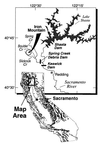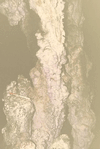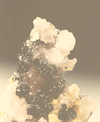Negative pH, efflorescent mineralogy, and consequences for environmental restoration at the Iron Mountain Superfund site, California
- PMID: 10097057
- PMCID: PMC34288
- DOI: 10.1073/pnas.96.7.3455
Negative pH, efflorescent mineralogy, and consequences for environmental restoration at the Iron Mountain Superfund site, California
Abstract
The Richmond Mine of the Iron Mountain copper deposit contains some of the most acid mine waters ever reported. Values of pH have been measured as low as -3.6, combined metal concentrations as high as 200 g/liter, and sulfate concentrations as high as 760 g/liter. Copious quantities of soluble metal sulfate salts such as melanterite, chalcanthite, coquimbite, rhomboclase, voltaite, copiapite, and halotrichite have been identified, and some of these are forming from negative-pH mine waters. Geochemical calculations show that, under a mine-plugging remediation scenario, these salts would dissolve and the resultant 600,000-m3 mine pool would have a pH of 1 or less and contain several grams of dissolved metals per liter, much like the current portal effluent water. In the absence of plugging or other at-source control, current weathering rates indicate that the portal effluent will continue for approximately 3, 000 years. Other remedial actions have greatly reduced metal loads into downstream drainages and the Sacramento River, primarily by capturing the major acidic discharges and routing them to a lime neutralization plant. Incorporation of geochemical modeling and mineralogical expertise into the decision-making process for remediation can save time, save money, and reduce the likelihood of deleterious consequences.
Figures







References
-
- USEPA (U.S. Environmental Protection Agency) (1985) Wastes from Extraction and Beneficiation of Metallic Ores, Phosphate Rock, Asbestos, Overburden from Uranium Mining, and Oil Shale: Report to Congress EPA/530-SW-85–033.
-
- Nordstrom D K, Alpers C N Reviews in Economic Geology, editors. In: Environmental Geochemistry of Mineral Deposits. Plumlee G S, Logsdon M J, editors. Littleton, CO: Soc. Econ. Geol.; 1999. , in press.
-
- Choprapawon, C. (1998) Abstracts of International Conference on Arsenic Pollution of Ground Water in Bangladesh: Causes, Effects, and Remedies; Dhaka, Feb. 8–12, 1998, pp. 77–78.
-
- Church T, Arimoto R, Barrie L A, Dehairs F, Dulac F, Jickells T D, Mart L, Sturges W T, Zollar W H. In: The Long-Range Atmospheric Transport of Natural and Contaminant Substances. Knap A H, editor. Dordrecht, the Netherlands: Kluwer; 1990. pp. 37–58.
-
- Buat-Ménard P. In: Global Atmospheric Chemical Change. Hewitt C N, Sturges W T, editors. Amsterdam: Elsevier Science; 1993. pp. 271–311.
LinkOut - more resources
Full Text Sources
Other Literature Sources
Research Materials

